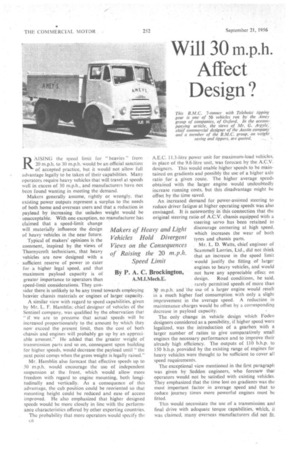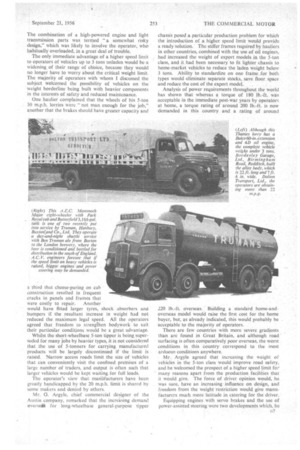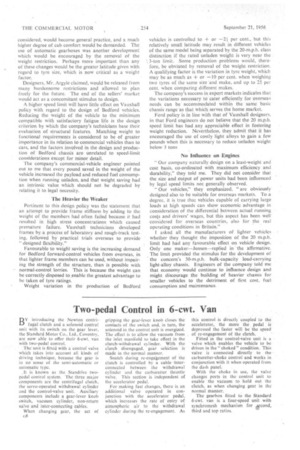Will 30 m.p.h.
Page 124

Page 125

Page 126

If you've noticed an error in this article please click here to report it so we can fix it.
Affect Design?
RAISING the speed limit for " heavies " from 20 m.p.h. to 30 m.p.h. would be an official sanction of accepted practice, but it would not allow full advantage legally to be taken of their capabilities. Many operators require heavy vehicles that will travel at speeds well in excess of 30 m.p.h., and manufacturers have not been found wanting in meeting the demand.
Makers generally assume, rightly or wrongly. that existing power outputs represent a surplus to the needs of both home and overseas users and that a reduction in payload by increasing the unladen weight would be unacceptable. With one exception, no manufacturer has claimed that a speed-limit change will materially influence the design of heavy vehicles in the near future.
Typical of makers' opinions is the comment, inspired by the views of Thornycroft technicians, that heavy vehicles are now designed with a sufficient reserve of power to cater for a higher legal speed, and that maximum payload capacity is of greater importance to operators than speed-limit considerations. They consider there is unlikely to be any trend towards employing heavier chassis materials or engines of larger capacity.
A similar view with regard to speed capabilities, given by Mr, L. F. Hamblin; chief designer of vehicles of the Sentinel company, was qualified by the observation that "if we are to presume that actual speeds will be increased proportionately to the. amount by which they now exceed the present limit, then the cost of both chassis and engines will probably go up by an appreciable amount." He added that the greater weight of transmission parts and so on, consequent upon building for higher speeds, would decrease the payload until "the .next point comps when the gross weight is legally raised."
Mr. Hamblin also forecast that effective speeds up to 50 m.p.h. would encourage the use of independent suspension at the front, which would allow more freedom with regard to engine mounting, both longitudinally and vertically. As a consequence of this advantage, the cab position could be reoriented so that mounting height could be reduced and ease of access improved. He also emphasized that higher designed speeds would he more closely in line with the performance characteristics offered by other exporting countries.
The probability that more operators would specify the
A.E.C. 11.3-litre power unit for maximum-load vehicles, in place of the 9.6-litre unit, was forecast by the A.C.V. designers. This would enable higher speeds to be maintained on gradients and possibly the use of a higher axle ratio . for a given route. The higher average speeds obtained with the larger engine would undoubtedly increase running costs, but this disadvantage might be offset by the time saved.
An increased demand for power-assisted steering to reduce driver fatigue at higher operating speeds was also envisaged. It is noteworthy in this connection that the original steering ratio of A.C.V. chassis equipped with a steering servo has been retained to discourage cornering at high speed, which increases the wear of both tyres and chassis parts.
. Mr. L. D. Watts, chief engineer of Scammell Lorries, Ltd., did not think that an increase in the speed limit would justify the fitting of larger engines to heavy vehicles, and would not have any appreciable effect on
design. Road conditions, he said, rarely permitted speeds of more than 3p m.p.h, and the use of a larger engine would result in a much higher fuel consumption with only a slight improvement in the average speed. A reduction in maintenance charges would be offset by a corresponding decrease in payload capacity.
The only change in vehicle design which Foden designers considered as a possibility, if higher speed were legalized, was the introduction of a gearbox with a larger number of ratios to give comparatively small engines the necessary performance and to improve their already high efficiency. The outputs of 110 b.h.p. to 150 b.h.p. provided by the existing range of engines for heavy vehicles were thought to be sufficient to cover all speed requirements.
The exceptional view mentioned in the first paragraph was given by Seddon engineers, who foresaw that operators would not be satisfied with existing vehicles. They emphasized that the time lost on gradients was the most important factor in average speed and that to reduce journey times more powerful engines must -be fitted.
This would necessitate the use of a transmission and final drive with adequate torque capabilities, which, it was claimed, many overseas manufacturers did not fit.
The combination of a high-powered engine and light transmission parts was termed "a somewhat risky design," which was likely to involve the operator, who habitually overloaded, in a great deal of trouble.
The only immediate advantage of a higher speed limit to operators of vehicles up to 3 tons unladen would be a widening, of their range of choice, because they would no longer have to worry about the critical weight limit The majority of operators with whom I discussed the subject welcomed the possibility of vehicles on the weight borderline being built with heavier components in the interests of safety and reduced maintenance.
One haulier complained that the wheels of his 5-ton 30 m.p.h. lorries were "not man enough for the job,". another that the brakes should have greater capacity and a third that cheese-paring on cab construction resulted in frequent cracks in panels and frames that were costly to repair. Another would have fitted larger tyres, shock absorbers and bumpers if -the resultant increase in weight had not reduced the maximum legal speed. All the operators agreed that freedom to strengthen bodywork to suit their particular conditions would be a great advantage.
Whilst the short-wheelbase 5-ton tipper is being.superseded for many jobs by heavier types, it is not considered that the use of 5-tonners for carrying manufactured products will be largely discontinued if the limit is raised. Narrow access roads limit the size of vehicles that can conveniently visit the confined premises of a large number of traders, and output is often such that larger vehicles would be kept waiting_ for full loads.
The operator's view that mantfacturers have been greatly handicapped by the 20 m.p.h. limit is shared by some makers and denied by others.
Mr. G. Argyle, chief commercial designer of the Austin company, remarked that the increasing demand oversee for long-wheelbase general-purpose tipper chassis posed a particular production problem for which the introduction of a higher speed limit would provide a ready solution. • The stiffer frames required by hauliers in other countries, combined with the use of oil engines, had increased the weight of export models in the 5-ton class, and it had been necessary to fit lighter chassis to home-market vehicles to reduce the laden weight below 3 tons. Ability to standardize on one frame for both types would eliminate separate stocks, save floor space and reduce the cost of the export model.
Analysis of power requirements throughout the world has shown that whereas a torque of 180 lb.-ft. was acceptable in the immediate post-war years by operators at home, a torque rating of around 200 lb.-ft. is now demanded in this country and a rating of around 220 lb.-ft. overseas. Building a standard home-andoverseas model would raise the first cost for the home buyer, but, as already indicated, this would probably be acceptable to the majority of operators.
There are few countries with more severe gradients than are found in Great Britain, and although road ' surfacing is often comparatively poor overseas, the worst conditions in this country correspond to the most arduous conditions anywhere.
Mr.. Argyle agreed that increasing the weight of vehicles in the 5-ton class would improve road safety, and he welcomed the prospect of a higher speed limit for many reasons apart from the production facilities that' it would give. The force of driver opinion would, he was sure, have an increasing influence on design, and freedom from the weight restriction would give manufacturers much more latitude in catering for the driver.
Equipping engines with servo brakes and the use of power-assisted steering were two developments which, he considered, would become general practice, and a much higher degree of cab comfort would be demanded. The use of automatic gearboxes was another development which would be encouraged by the removal of the weight restriction. Perhaps more important than any of these changes would be the greater latitude given with regard to tyre size, which is now critical as a weight factor.
Designers, Mr. Argyle claimed, would be released from many burdensome restrictions and allowed to plan freely for the future. The end of the sellers' market would act as a concomitant stimulus to design.
A higher speed limit will have little effect on Vauxhall policy with regard to the design of Bedford vehicles. Reducing the weight of the vehicle to the minimum compatible with satisfactory fatigue life is the design criterion by which the company's technicians base their evaluation of structural features. Matching weight to functional requirements is considered to be of greater importance in its relation to commercial vehicles than to cars, and the factors involved in the design and production of Bedford chassis are unrelated to speed-limit considerations except for minor detail.
The company's commercial-vehicle engineer pointed out to me that every pound saved in the weight of the vehicle increased the payload and reduced fuel consumption when running unladen, and that weight saving had an intrinsic value which should not be degraded by relating it to legal necessity.
The Heavier the Weaker Pertinent to this design policy was the statement that an attempt to provide frame stiffness by adding to the weight of the members had often failed because it had resulted in high stress concentrations which caused premature failure. Vauxhall technicians developed frames by-a process of laboratory and rough-track testing, followed by practical trials overseas to provide designed flexibility."
Favourable to weight saving is the increasing demand for Bedford forward-control vehicles from overseas, in that lighter frame members can be used, without impairing the strength of the structure, than is possible with normal-control lorries, This is because the weight can be correctly disposed to enable the greatest advantage to be taken of tyre ratings.
Weight variation in the production of Bedford
vehicles is controlled to -Ior —21 per cent., but this relatively small latitude may result in different vehicles of the same model being separated by the 20-m.p.h. class distinction if the rated unladen weight is very near the 3-ton limit. Some production problems would, therefore, be obviated by removal of the weight restriction. A qualifying factor is the variation in tyre weight, which may be as much as + or —10 per cent. when weighing two tyres of the same size and make, and up to 25 per cent, when comparing different makes.
The company's success in export markets indicates that the variations necessary to eater efficiently for overseas needs can be accommodated within the same basic chassis range as that which serves the home market.
Ford policy is in line with that of Vauxhall designers, in that Ford engineers do not believe that the 20 m.p.h. speed limit has had any appreciable effect in fostering weight reduction. Nevertheless, they admit that it has encouraged the use of costly light alloys to gain a few pounds when this is necessary to reduce unladen weight below 3 tons No Influence on Engines "Our company naturally design on a least-weight and cost basis, co-ordinated with maximum efficiency and durability," they told me. They did not consider that the size and output of power units had been influenced by legal speed limits not generally observed.
"Our vehicles," they emphasized, "are obviously designed also to he suitable for overseas markets, To a degree, it is true that vehicles capable of carrying large loads at high speeds can show economic advantage in consideration of the differential between actual running costs and drivers' wages, but this aspect has been well considered for overseas countries, also for the real operating conditions in Britain:" I asked all the manufacturers of lighter vehicles whether they thought the imposition of the 20 m.p.h. limit had had any favourable effect on vehicle design. Only one maker--lensen—replied in the affirmative. The limit provided the stimulus for the development of the concern's 30-m.p.h. bulk-capacity load-carrying light-alloy chassis. Engineers of the company told me that economy would continue to influence design and might discourage the building of heavier chassis for smaller vehicles to the detriment of first cost, fuel consumption and maintenance.




































































































































































































































































































































